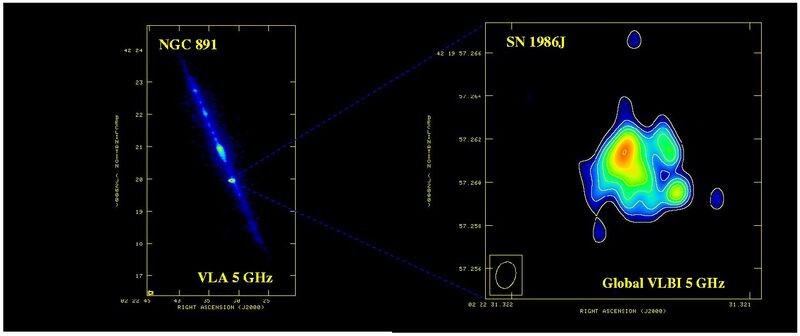Supernova 1986J
Description
SN 1986J in the galaxy NGC 891 is one of the most radio luminous supernovae ever discovered. Indeed, at a distance of about 31 million light-years, it had a peak luminosity at 5 GHz about 8 and 13 times greater than SN 1979c and SN 1993J, respectively. SN 1986J was so bizarre that it was serendipitously discovered first in the radio, and afterwards in the optical. Therefore, the precise date of its explosion is not known, but on the basis of the available radio and optical data SN1986J has been estimated to have exploded around the end of 1982, or the beginning of 1983. The left panel is a VLA image of NGC891 at 5 GHz. The brightest spot in the galaxy (in red color in the image) corresponds to the supernova SN1986J. The right panel is a Global Very Long Baseline Interferometry (VLBI) image of SN1986J at 5 GHz. The VLBI array included the VLBA, the VLA, Effelsberg (Germany), Onsala (Sweden), and Medicina and Noto (Italy). The high-resolution image shows a distorted shell of radio emission, indicative of a strong deformation of the shock front. There are several bright knots that delineate a shell-like structure, and an absolute minimum of emission, which could be tentatively identified with the centre of the supernova explosion. If this is the case, SN1986J has then suffered an asymmetric expansion. The asymmetric structure of the radio supernova is likely to be due to the collision of the ejecta with an anisotropic, clumpy (or filamentary) medium. The speed at which the supernova shock is currently expanding into the circumstellar medium is as high as 6,300 kilometers per second, with no evidence of strong deceleration for the last 10 years.
Creator
Legacy Astronomical Images
Rights
NRAO/AUI/NSF does not hold full copyright for this image. Contact the archivist for details.
Type
Legacy Astronomical Image
Object Name
SN 1986J
Investigators
M.A. Perez-Torres, A. Alberdi, J.M. Marcaide, J.C. Guirado, L. Lara, F. Mantovani, E. Ros., K.W. Weiler
Telescope
Very Large Array (VLA)
Very Long Baseline Interferometry
Observation Date
1999-02-00
Type of Observation
continuum
Band
C
Wavelength
6 cm
Frequency
5.0 GHz
Center of Image
RA 2:22:31.330, Dec: 42:19:56.400 (J2000)
Field of View
0.000004 x 0.000004 degrees
Series
Galactic Sources Series
Unit
Supernovae Unit
Citation
Legacy Astronomical Images, “Supernova 1986J,” NRAO/AUI Archives, accessed June 14, 2025, https://www.nrao.edu/archives/items/show/33528.

